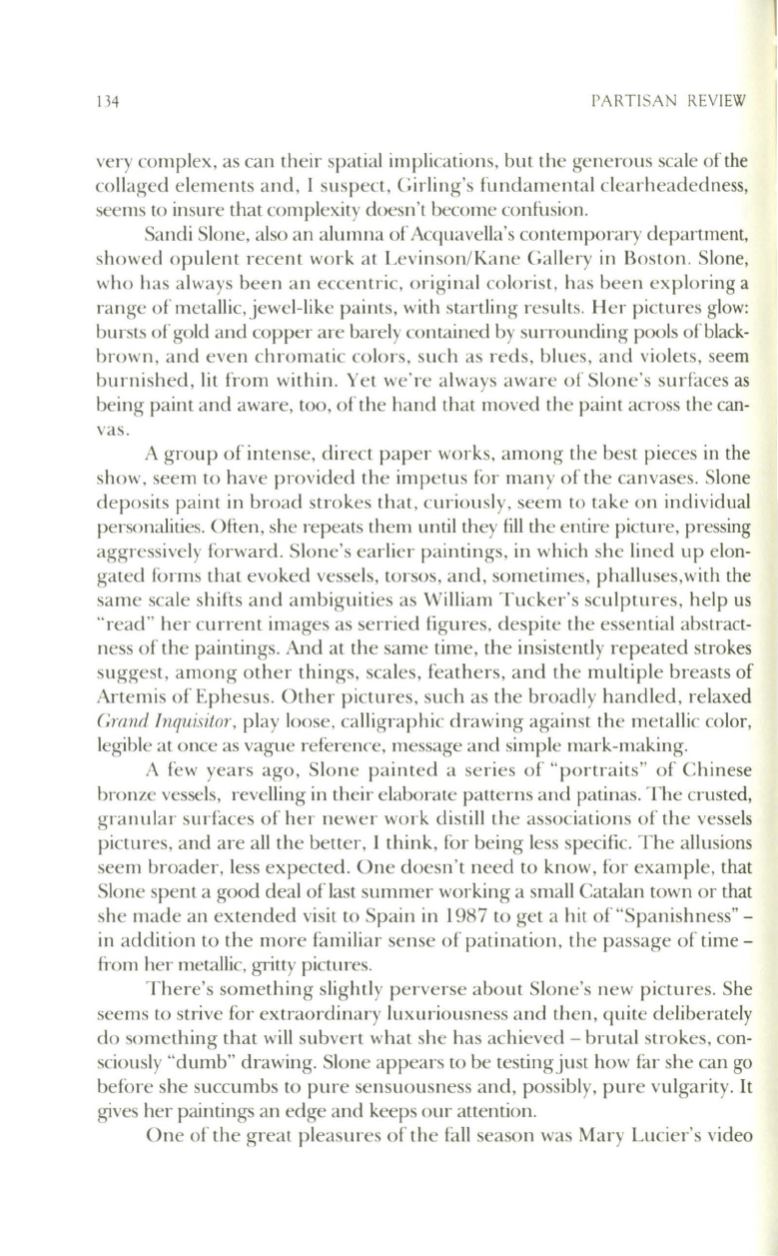
134
PARTISAN REVIEW
very complex, as can their spatial implications, but the generous scale of the
collaged elements and, I suspect, Girling's fundamental clearheadedness,
seems to insure that complexity doesn't become confusion.
Sandi Slone, also an alumna ofAcquavella's contemporary department,
showed opulent recent work at Levinson/ Kane Gallery in Boston. Slone,
who has always been an eccentric, original colorist, has been exploring a
range of metallic, jewel-like paints, with startling results. Her pictures glow:
bursts of gold and copper are barely contained by sU'Tounding pools of black–
brown, and even chromatic colors, such as reds, blues, and violets, seem
burnished, lit from within. Yet we're always aware of Slone's surfaces as
being paint and aware, too, of the hand that moved the paint across the can–
vas.
A group of intense, direct paper works, among the best pieces in the
show, seem
to
have provided the impetus for many of the canvases. Slone
deposits paint in broad strokes that, curiously, seem
to
take on individual
personalities. Often, she repeats them until they fIJI the entire picture, pressing
aggressively forward. Slone's earlier paintings, in which she lined up elon–
gated forms that evoked vessels, torsos, and, sometimes, phalluses,with the
same scale shifts and ambiguities as William Tucker's sculptures, help us
'·read" her current images as serried figures, despite the essential abstract–
ness of the paintings. And at the same time, the insistently repeated strokes
suggest, among other things, scales, feathers, and the multiple breasts of
Artemis of Ephesus. Other pictures, such as the broadly handled, relaxed
Grand Inquisitor,
play loose, calligraphic drawing against the metallic color,
legible at once as vague reference, message and simple mark-making.
A few years ago, Slone painted a series of "portraits" of Chinese
bronze vessels, revelling in their elaborate patterns and patinas. The crusted,
granular surfaces of her newer work distill the associations of the vessels
pictures, and are all the better, I think, for being less specific. The allusions
seem broader, less expected. One doesn't need to know, for example, that
Slone spent a good deal oflast summer working a small Catalan town or that
she made an extended visit to Spain in 1987 to get a hit of "Spanishness" -
in addition
to
the more familiar sense of patination, the passage of time -
1T0m her metallic, gritty pictures.
There's something slightly perverse about Slone's new pictures. She
seems
to
strive for extraordinary luxuriousness and then, quite deliberately
do something that will subvert what she has achieved - brutal strokes, con–
sciously "dumb" drawing. Slone appears to be testing just how far she can go
before she succumbs to pure sensuousness and, possibly, pure vulgarity.
It
gives her paintings an edge and keeps our attention.
One of the great pleasures of the fall season was Mary Lucier's video


